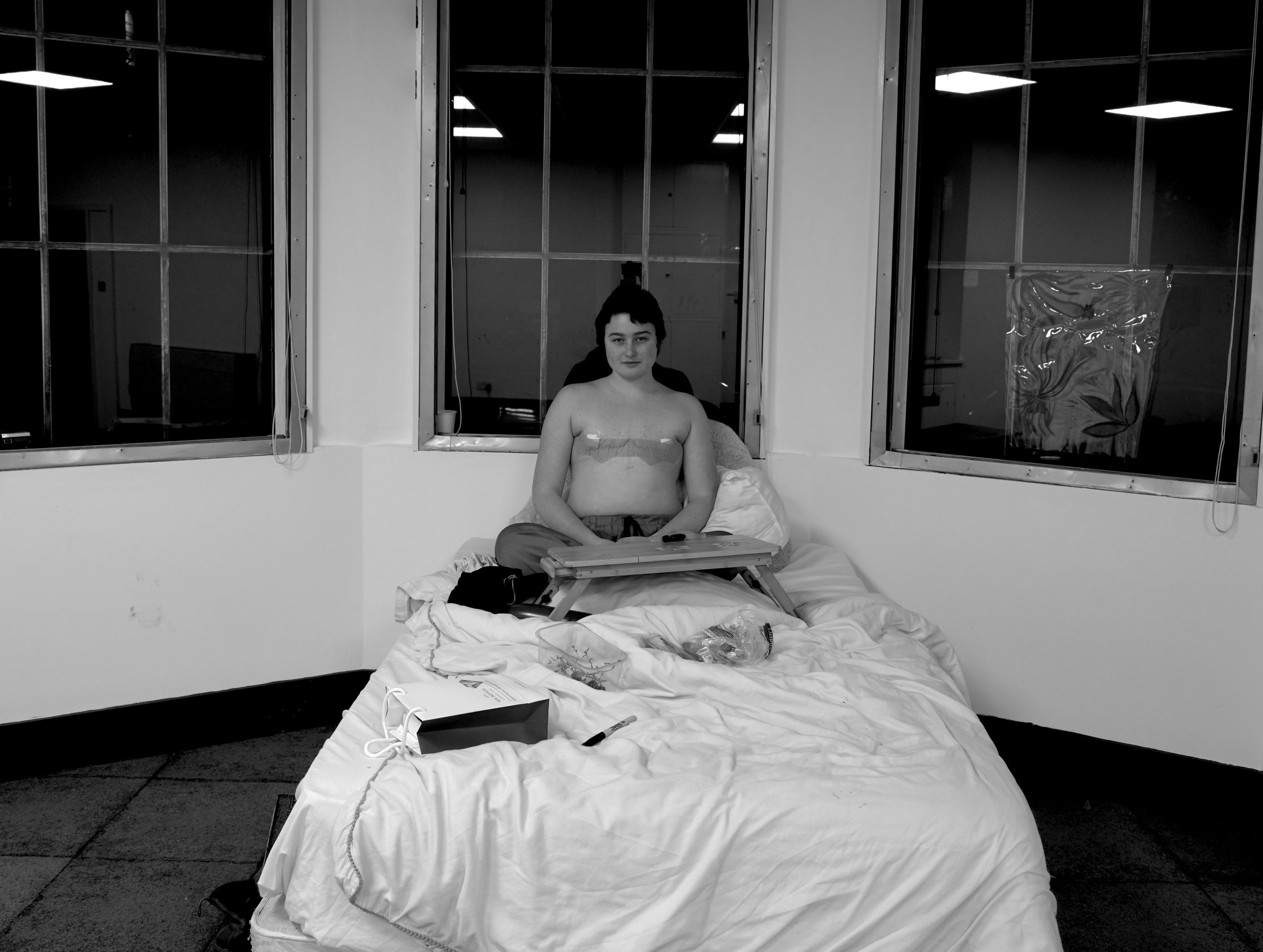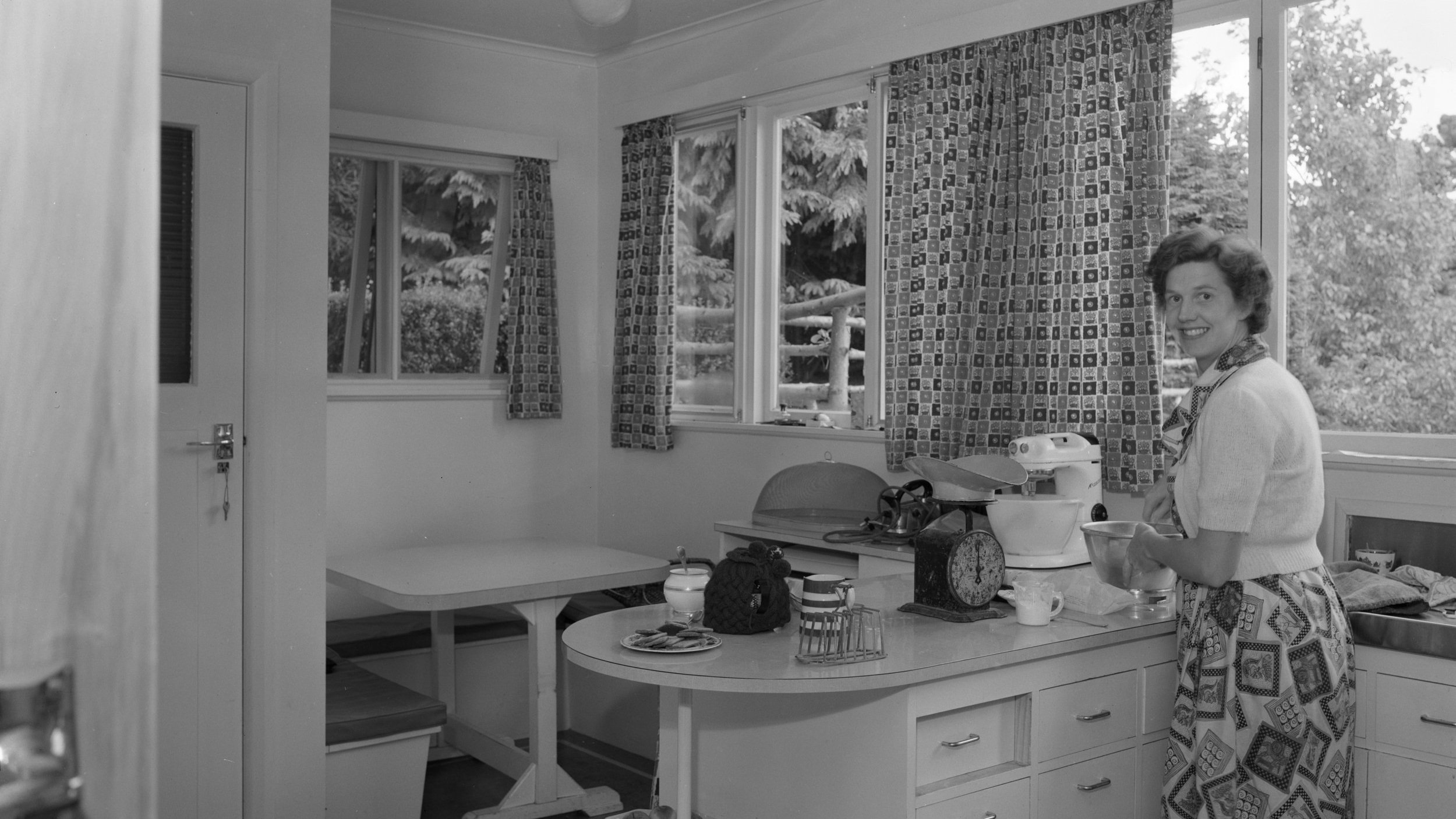Exhibiting My Recovery from Gender Affirming Top Surgery Showed Me There is Value in Vulnerability
Performer, visual artist and writer Fleur Bloemsma reflects on sharing their recovery from top surgery in a durational performance exhibition at the Koppel Project Studios. In a moving summation of observations, Fleur processes encounters in all their emotive, heartwarming and uneasy varieties.
By Fleur Bloemsma
It was two months before my top surgery and the reality of the procedure was becoming more and more tangible. As I was cycling, I found myself overthinking my existence as a trans non-binary person, and how I might be treated differently after my surgery – what other realities might I be faced with?
Four years ago I existed in a straight white cis female body. Our world had hidden the lives of trans people from me by removing them from our education systems, so thoughts surrounding gender identity didn’t cross my mind. Realising this sparked an urge inside me to create a space that would allow for conversation, bring awareness and education, and most importantly, offer an opportunity to engage human-to-human in a safe and open environment about the experience of being trans.
The durational performance I devised as a result would see me share my recovery from top surgery with the public in the Koppel Project Studios. I formulated it as both an art piece and a critique on the separation between the trans and cis communities. The bed I lay in for my performance was where my recovery from top surgery was taking place, and also where people could come to converse with me whilst this was happening. The bed is a familiar place; it is a place where people naturally exist during their most vulnerable states, such as sleep, recovery, or love. By inviting people to be open and chat with me about my experience, in an environment where they wouldn’t be judged, I wanted to offer something I’d wished I had access to in the past.
Among the many questions I received, I think the most popular was “When did you know you wanted top surgery?”, to which I would go on to explain that I don't think it can be pinned to a moment. As soon as my chest developed, I felt uncomfortable with my bust, and found myself hunching my back and not standing as proud. While I tried to learn from the way others dressed and project a hyper feminine image to fit in as a teenager, I always felt a deep sadness that I couldn't place. I eventually went back to cutting all my hair and wearing baggy clothes, before discussing top surgery with a trans male and acknowledging that I might also need it – even though I still identified as female at the time. That was three years ago now, at which point I began my journey to get top surgery. I realised gender identity isn't simple; it can be messy, clean, fast or slow, it is different for everyone.
While the questions people asked during the exhibition didn’t tend to make me uncomfortable, there were certain actions that did. I noticed when people sat on the bed, but didn't face me or look me in the eyes. Sometimes I would offer to show people my chest and they would take steps back, unable to bear looking at it, even with my nipples and scars taped up. Although reactions like these made me feel uncomfortable at points, I also felt that it was important to show people my body. Sometimes change is uncomfortable.
I think the interaction that stuck with me the most was with a woman who came in on the last day and asked me what the deepest question I’d been asked was. I sat and thought about it for a while. I didn’t really have an answer; even though I had been talking about a very personal subject matter everyday, I hadn’t really been emotionally moved. A lot of the conversations had been extremely beautiful and insightful, but none had hit me hard. She went on to ask, “What do you wished you were asked?”, and after a minute of thought, I answered, “I wish I was asked what I want for the future of trans people, and what I hope to come from this exhibition.” When she then asked me this question, it was the first time during the exhibition that I cried, and she held my leg as I answered.
I was quite nervous when starting the exhibition, as I was at the beginning of my recovery and in a very vulnerable state. Beyond this, Brianna Ghey, a 16-year-old trans girl, had been brutally murdered just a few days before my exhibition was due to start. It made the opening much more intense. I really felt I wanted to give the performance my all, as a love message to her and all my other trans siblings that had their lives taken too soon. The news of her death also brought with it an element of fear around my own safety, so as a precaution, I got a security button installed to alert security if there was a hate crime or attack during my time at the exhibition.
Luckily, my visitors gave me no reason to use it. They belonged to a broad range of demographics, from old to young, and from cishet to queer. A lot of young trans people who were questioning their gender and whether they would want surgery also attended, along with people who were soon to undergo gender affirming surgeries. Originally, I hadn’t intended to target the trans community with this performance piece, but the outcome made sense to me afterwards when I considered that we are all still learning about ourselves and our relationships with our bodies. This was a wonderful surprise to have come from this performance.
“I realised gender identity isn't simple; it can be messy, clean, fast or slow, it is different for everyone.”
This exhibition has given me hope that people can change, and has brought me more peace when communicating with people who don't know much about transness. Having completed my durational performance, I feel equally relieved and sad that it's over. I am quite emotionally exhausted, as these daily conversations with people could last hours, and sometimes it was person after person. At the same time, it was this quality of the exhibition that allowed me to gain insight – people would open up to me with crazy stories and confessions in ways that they might not be able to in their day to day life, so the sharing of experiences was mutual. So often we put our guards up to protect ourselves, but I feel that by not having spaces where we are able to openly ask questions without the fear of being wrong, we risk separating people and communities, leading to generalisations and hive mentality.
The kindness of people visiting and making real connections in the space really warmed me; I expected the room to stay a blank canvas in a cold police station, but as the week progressed I received more and more flowers, cards, and presents in the form of paintings, food and drink that began to fill the room. People who I hadn’t known before came to visit me a second time. I watched the space transform as the week went on and felt extremely thankful for friends and strangers. I think what I have learnt from this experience is the value of communication and vulnerability in the world.
To read more about Fleur’s experiences and the progression of the week, please head to their website for a short documentary and images. You can also see their latest works on Instagram @the_creature_fleur.
To donate to help other trans people to get their gender affirming surgeries go to @transfund4london and click the link in their bio. By following them, you can also stay up-to-date with coming events that support funding for trans surgeries.


















